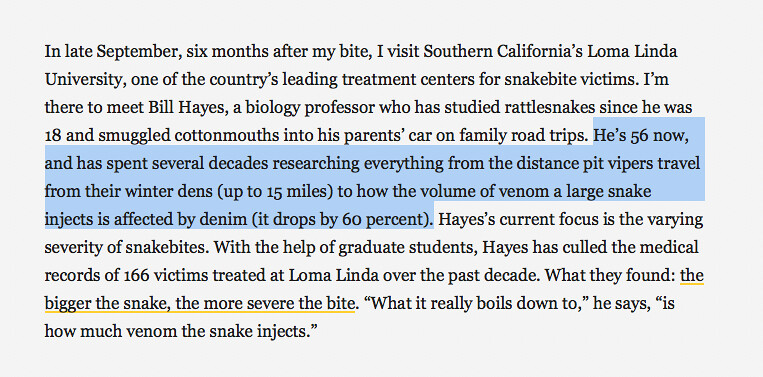Re: SPOT 911 for Rattlesnake Bite?
Posted: Mon Jan 07, 2019 1:11 pm
@Bobby 49....Here is a clip from the article that mentions denim:bobby49 wrote: ↑Mon Jan 07, 2019 12:21 pmI think that you are confusing the issue or else misinterpreting the article. Denim as an absorber might work if the venom was on top of the skin. However, it is not. Venom is injected to the tissues a fraction of an inch below the skin surface, and there is no denim working there. Venom left above the skin surface has virtually no significance. Some people feel as though venom below the skin can be squeezed out, but there is also a good possibility of squeezing it might work it deeper. Vacuum extraction might work a little, but it has to be done fairly rapidly.freestone wrote: ↑Sat Jan 05, 2019 11:36 pmAccording to the article denim is an absorber, up to 60% which can be significant because the amount of venom injected on the strike is directly proportional to how sick the victim will become. Older bigger snakes are much more dangerous because they can produce and store more venom than young baby rattlers. I don't think there is any way to determine if or how much venom was injected on any given strike, so any bite would have to be treated as a worst case scenario.bobby49 wrote: ↑Sat Jan 05, 2019 10:10 pmThe thick denim will work a little, because it blocks the fangs from sinking into the skin quite so far. In other words, the snake might bite all the way into your skin, and it might just get a piece of denim. If you were in snake country and if you were really concerned, rig up some ordinary knee-high gaiters with a piece of thick denim or else leather underneath the nylon. On a full-stroke snakebite, the depth of penetration is only a fraction of an inch, maybe a quarter inch. So, the denim might act as more of a shield than an absorber.
I think most of us hear that death by snake bite is rare but what we don't hear about are the complexities and logistics for treatment then the long term followup care that is required as a result of the bite.
I have never seen rattlers in the High Sierra but hardly ever do I go into the Los Padres without seeing multiple snakes on any given trip, I don't want to go overboard on prevention so wearing denim jeans instead of thin UL nylon pants (or shorts) could be a reasonable compromise on weight and functionality. The UL backpacking mantra has always been "cotton kills" but maybe that's overstated when in the company of rattlers.
My first training was that rattlesnakes never go above 6000 feet elevation in Yosemite. Then I saw one there at 6000 feet. In Sequoia-Kings I thought they went that high or slightly higher. Then I saw one at 9050 feet.
